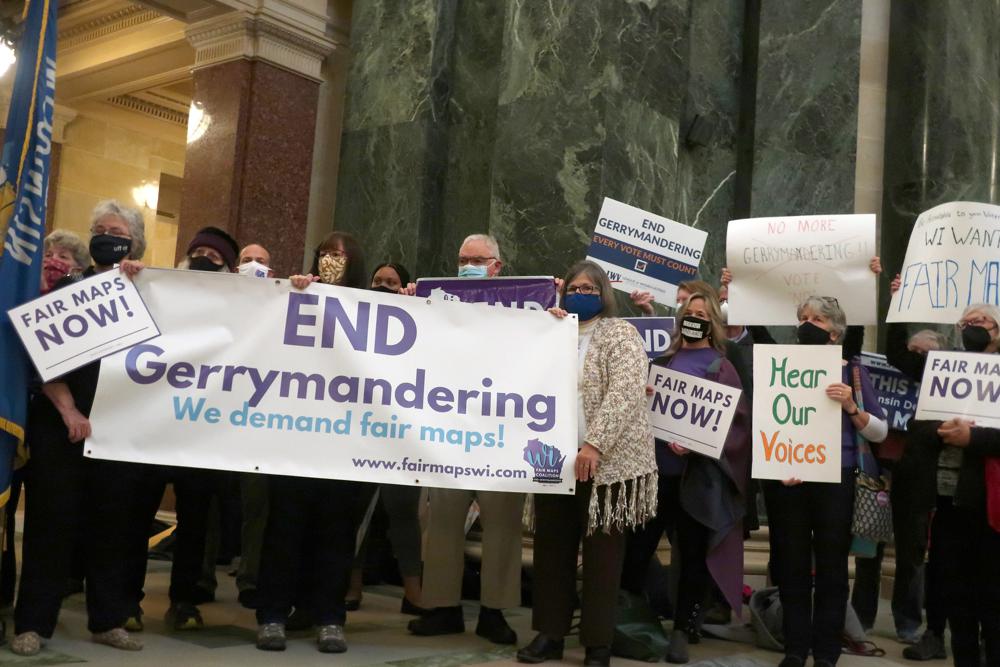Politics
Wisconsin Supreme Court weighs competing redistricting maps

MADISON, Wis. (AP) — Wisconsin Supreme Court justices on Wednesday weighed which map they should order enacted to set political boundaries for the next decade in the battleground state, with competing partisan interests arguing why theirs was the best option.
The daylong hearing — an unprecedented amount of time for cases before the Supreme Court — put on display arguments from attorneys representing Democratic Gov. Tony Evers, the Republican-controlled Legislature, Democratic lawmakers and other interest groups.
Sam Hirsch, an attorney representing mathematicians, statisticians and computer scientists at the University of Wisconsin and Marquette University, pitched the maps they created as a nonpartisan alternative for the court to adopt.
“It’s the best thing for the state of Wisconsin and the people of Wisconsin and they will forever respect you for that decision,” Hirsch said.
The court was expected to issue a final decision within weeks to set the maps in time for candidates running for office this fall. There is also a federal lawsuit pending brought by Democrats that could be taken up after the Supreme Court issues its decision.
The state Supreme Court’s ruling will be limited.
The conservative-controlled court ruled 4-3 in November that it will adopt a “least change” approach and not make significant alterations to the current GOP-drawn maps enacted in 2011. That was a major win for Republicans, who drew the maps last time and have increased their majorities in the Legislature and Congress since.
The state court, like the U.S. Supreme Court, also ruled that it would not consider the partisan makeup of districts when drawing legislative maps, saying it has no standard to judge whether maps present an unfair partisan advantage.
The map submitted by Evers complies most closely with the criteria set out by the Supreme Court and complies with the federal Voting Rights Act, argued Wisconsin Department of Justice attorney Anthony Russomanno, who represents the governor.
The Legislature’s attorney, Taylor Meehan, said the governor’s legislative map and one submitted by a coalition of groups are unconstitutional because they move too many people to create more districts with a majority of Black and Hispanic voters.
Justice Brian Hagedorn, who is frequently a swing vote, asked the attorney representing Senate Democrats what specifically was illegal about the maps approved by the Legislature.
The Legislature’s map moves too many people and does it for a partisan advantage, said attorney Tamara Packard.
“I think it’s highly likely that you’re correct, but I think it’s highly likely that every other map did the same thing,” Hagedorn said in response.
The Wisconsin Supreme Court has received proposed maps from Evers, the Legislature, Democratic voters, the Republican congressional delegation, legislative Democrats, Citizen Mathematicians and Data Scientists and a coalition of groups including Black Leaders Organizing for Communities, Voces de la Frontera and the League of Women Voters of Wisconsin.
Liberal justices asked whether there should be seven legislative districts in Milwaukee that have a majority of Black and Hispanic voters. Challengers to the maps drawn by the Republican-controlled Legislature argue that creating fewer than seven districts is a violation of the federal Voting Rights Act.
“Just because you can draw seven districts doesn’t mean that it’s required,” argued Meehan, the Legislature’s attorney.
Hagedorn and other conservative justices questioned whether the Voting Rights Act even applied in Milwaukee, citing races where Black candidates succeeded against white opponents.
All of the submitted maps had to adhere closely to the current boundary lines, per the court’s earlier order. The court said changes to the current maps should be limited to population shifts made apparent by the once-a-decade census.
Evers, for instance, submitted a map that would not be as favorable to Republicans as the one approved by the Legislature, but would maintain their majorities in the state Senate and Assembly.
Redistricting is the process of redrawing the state’s political boundaries based on the latest census showing how populations have changed in neighborhoods, cities and counties since 2010. Mapmakers can create an advantage for their political party in future elections by packing opponents’ voters into a few districts or spreading them thin among multiple districts — a process known as gerrymandering.
In 2018, Democrats won every statewide race but Republicans held more than 60% of legislative seats. Republicans blamed bad Democratic candidates, in part, while Democrats argued that gerrymandering enshrined the GOP advantage.
Republicans have a 61-38 majority in the Assembly and 21-12 majority in the Senate. They also hold five of eight congressional seats.
Republicans controlled the Legislature and governor’s office in 2011, the last time redistricting was done. Evers vetoed the Republican maps last year, putting the battle in court. Evers called the maps “gerrymandering 2.0.”
The U.S. Supreme Court last month rejected an attempt by Republican lawmakers to end the Democrats’ federal lawsuit. The federal court has deferred taking action on the Democrats’ lawsuit and has not said whether it will take up the case after the state Supreme Court case is concluded.

